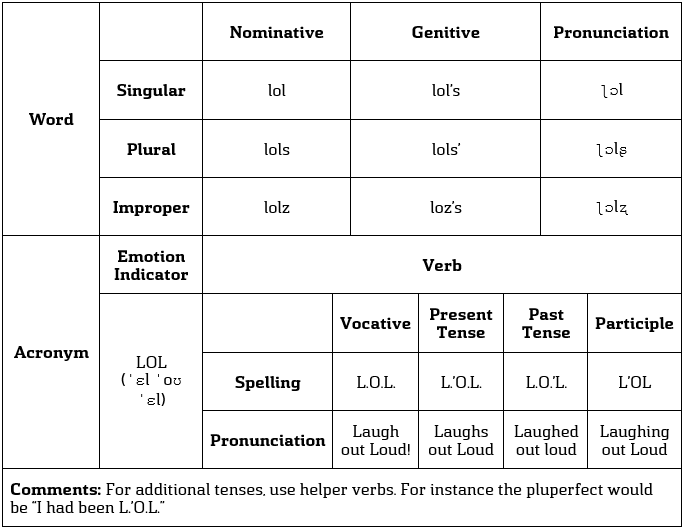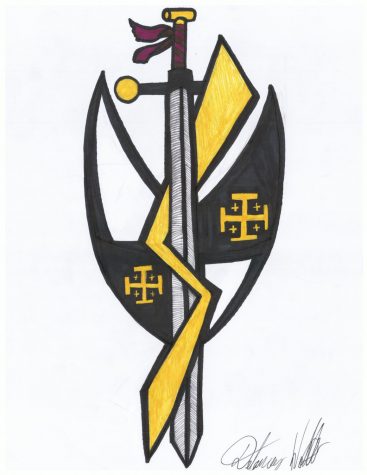Moralexicon #2: LOL
January 15, 2019
Overview
The linguistic construction spelt LOL (or lol) comes out of the late twentieth and early twenty-first centuries. It has a relatively simple history, despite its myriad of uses. This confusion is why, upon further study, it was declared neither a word nor an acronym but a unique category of language use.
History
As cell phones and the Internet became more common, someone had a genius idea.
Specific characters had been associated with specific numbers on the phone for quite some time. The new idea: what if you used these characters, along with the increasingly complex interface of the phone, to send text based messages to other cell phones? Service providers ran into one major problem: they could charge money per minute for calls, but texts were nearly impossible to compute in that manner. So they went with an old standby of the telegram days—charge per character/word, and if my memory serves me correctly, up to 160 characters per message. So, then, one would have a bunch of talk-happy teenagers drastically limited by what they can say, coupled with the lack of inflection which cut natural emotion out of their messages. The obvious question: how could they indicate emotional states, such as making it clear they were joking? It was from this that the construct called LOL, I believe it was pronounced “laugh out loud,” and was originally used to punctuate jokes.
Usage
Now, first and foremost, it is time we talked about the original use of the lolistic construction, the famous LOL. When used in this way, it is not so much a word but an acronym, and not only an acronym, but an imperative phrase. In short, LOL was initially a command (“laugh out loud!”); it is an instruction on how to respond to a cryptic message. If one were to get the message “i jst got hm 12 pg. chem 2 do,” that could mean several things. It could be a cry for help, a rant, etc. LOL was supposed to add context. It is like saying a bad joke, then going “you were supposed to laugh.” Due to this interpretation of the lolistic construction, there is a related reading of LOL called a verbal (or textual) emoticon. A statement followed by LOL becomes funny.
There is another verbal use of LOL. While LOL can be used to preface a statement, it can be used to respond to one too. If the message were to read “i jst got hm 12 pg. chem 2 do,” you can respond LOL. This does not mean the message was necessarily funny—I could have still been writing a cry for help—but it does mean that for whatever reason (maybe you’re sadistic) you find it funny. In this case I interpret LOL as “laughed out loud,” or, perhaps, “laughing out loud.” In any case, LOL represents your reaction to the statement. This, however, leads to a problem: how do you conjugate LOL, since the acronym would not change for tense? See below.
Now that I have addressed the major verbal uses of the the lolistic construction, I will discuss its nominal uses. Besides being related to emotion and reaction, in recent years LOL has become a noun, simultaneously becoming a word of its own. For example, it has become common to refer to doing things for LOLs (alternative spelling LOLz). This seems to imply two things: first, that one is doing something to provoke people to LOL. The other implication is that one is just doing something for the fun of it, two related but not necessarily equivalent concepts. In short, to do something for LOLs is to do something for the most reaction consisting of LOL responses.
In light of all of this information, I will now attempt to create the first bases for a field of lolistic grammar.
First and foremost, the verb form, and verb-related uses (both imperative and otherwise) should be expressed by the acronym LOL.
The noun form, I feel, needs regular spelling, and a working definition to distinguish meaning, and reconstruct language. First, as a noun it should be spelled l-o-l, with the correct capitalization as grammar requires, and should be pronounced [ɭoʊl]. Secondly, its respective plural should be spelled l-o-l-s and pronounced [ɭoʊlʂ]. It should not (except for humorous purposes) be pronounced [ɭoʊlʐ] and spelled respectively l-o-l-z. My belief is that if LOL is to become part of the English cannon as a noun, it must respect some rules of pronunciation and grammar. A noun should also have a reasonable definition. This is tricky, for LOL is often used as plural, so we will have to work backwards. To do something for the LOLs of it (as mentioned above) is to do something for the fun of it, or to provoke LOL. We can then expand this to assume that in order to do something for LOLs you are accomplishing a series of deeds to have fun experiences and to provoke laughter from those around you. We can deduce from this point that if doing something for the LOLs of it requires multiple events, to create multiple humorous fun experiences for you and/or those around you, then to do anything thing for a LOL, is to do something shorter for an equally brief joke. A text message might be a LOL, or perhaps a LOL is analogous to the word “lark” in the sense of doing something for a LOL seems to be reasonable use of the word. All of this considered, I think it is reasonable to purpose this definition:
LOL. n s A humorous moment for the enjoyment of oneself and others; or an action to cause the reaction of laughing out loud.
As mentioned, the verb usage is a slightly strange issue. We need an easy way to distinguish the imperative from the indicative verb, and a way of distinguish the past from the present, and so on. The common approach to the past tense probably is to say LOLed, but that just does not make sense. An acronym is an acronym, no matter how inconvenient. This kind of difficulty is why I have always felt that the lolistic construction was a scourge upon the language—yet, without a doubt, it has become part of that very language, so how do we work around this? I suggest the use of apostrophes to show changes to a word. For instance, “laughed out loud” would be L’OL, to make it clear it is “laughed,” rather than “laugh.”
To demonstrate all these ideas I have added the bwlo table.
Controversy
The lolistic construction embodies the spirit of a texting slang movement, along with notables such as OMG, JK, and others. Some consider it a plague on the language, and part of the universal deterioration of English. This view is not entirely unjustified, but it ought to be carefully considered, since LOL is ultimately only part of the movement.
Of course, part of the movement or its origin, welcoming every new slang term as part of normal speech will bring about the downfall of society as the least of its consequences.

